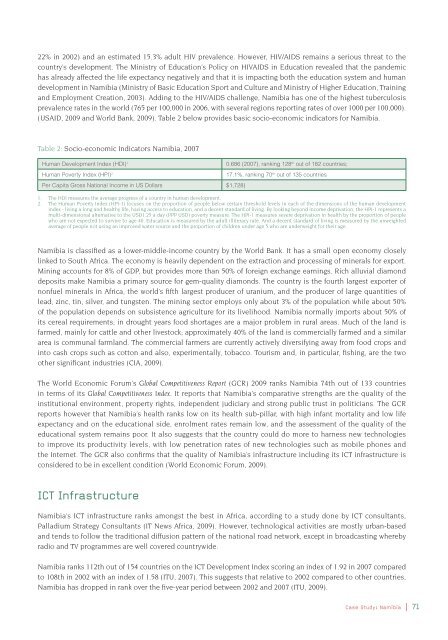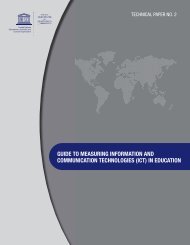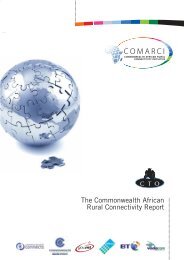Transforming education: the power of ICT policies - Commonwealth ...
Transforming education: the power of ICT policies - Commonwealth ...
Transforming education: the power of ICT policies - Commonwealth ...
You also want an ePaper? Increase the reach of your titles
YUMPU automatically turns print PDFs into web optimized ePapers that Google loves.
22% in 2002) and an estimated 15.3% adult HIV prevalence. However, HIV/AIDS remains a serious threat to <strong>the</strong><br />
country’s development. The Ministry <strong>of</strong> Education’s Policy on HIVAIDS in Education revealed that <strong>the</strong> pandemic<br />
has already affected <strong>the</strong> life expectancy negatively and that it is impacting both <strong>the</strong> <strong>education</strong> system and human<br />
development in Namibia (Ministry <strong>of</strong> Basic Education Sport and Culture and Ministry <strong>of</strong> Higher Education, Training<br />
and Employment Creation, 2003). Adding to <strong>the</strong> HIV/AIDS challenge, Namibia has one <strong>of</strong> <strong>the</strong> highest tuberculosis<br />
prevalence rates in <strong>the</strong> world (765 per 100,000 in 2006, with several regions reporting rates <strong>of</strong> over 1000 per 100,000).<br />
(USAID, 2009 and World Bank, 2009). Table 2 below provides basic socio-economic indicators for Namibia.<br />
Table 2: Socio-economic Indicators Namibia, 2007<br />
Human Development Index (HDI) 1 0.686 (2007), ranking 128th out <strong>of</strong> 182 countries;<br />
Human Poverty Index (HPI) 2 17.1%, ranking 70th out <strong>of</strong> 135 countries<br />
Per Capita Gross National Income in US Dollars $1,728)<br />
1. The HDI measures <strong>the</strong> average progress <strong>of</strong> a country in human development.<br />
2. The Human Poverty Index (HPI-1) focuses on <strong>the</strong> proportion <strong>of</strong> people below certain threshold levels in each <strong>of</strong> <strong>the</strong> dimensions <strong>of</strong> <strong>the</strong> human development<br />
index - living a long and healthy life, having access to <strong>education</strong>, and a decent standard <strong>of</strong> living. By looking beyond income deprivation, <strong>the</strong> HPI-1 represents a<br />
multi-dimensional alternative to <strong>the</strong> USD1.25 a day (PPP USD) poverty measure. The HPI-1 measures severe deprivation in health by <strong>the</strong> proportion <strong>of</strong> people<br />
who are not expected to survive to age 40. Education is measured by <strong>the</strong> adult illiteracy rate. And a decent standard <strong>of</strong> living is measured by <strong>the</strong> unweighted<br />
average <strong>of</strong> people not using an improved water source and <strong>the</strong> proportion <strong>of</strong> children under age 5 who are underweight for <strong>the</strong>ir age.<br />
Namibia is classifi ed as a lower-middle-income country by <strong>the</strong> World Bank. It has a small open economy closely<br />
linked to South Africa. The economy is heavily dependent on <strong>the</strong> extraction and processing <strong>of</strong> minerals for export.<br />
Mining accounts for 8% <strong>of</strong> GDP, but provides more than 50% <strong>of</strong> foreign exchange earnings. Rich alluvial diamond<br />
deposits make Namibia a primary source for gem-quality diamonds. The country is <strong>the</strong> fourth largest exporter <strong>of</strong><br />
nonfuel minerals in Africa, <strong>the</strong> world’s fi fth largest producer <strong>of</strong> uranium, and <strong>the</strong> producer <strong>of</strong> large quantities <strong>of</strong><br />
lead, zinc, tin, silver, and tungsten. The mining sector employs only about 3% <strong>of</strong> <strong>the</strong> population while about 50%<br />
<strong>of</strong> <strong>the</strong> population depends on subsistence agriculture for its livelihood. Namibia normally imports about 50% <strong>of</strong><br />
its cereal requirements; in drought years food shortages are a major problem in rural areas. Much <strong>of</strong> <strong>the</strong> land is<br />
farmed, mainly for cattle and o<strong>the</strong>r livestock; approximately 40% <strong>of</strong> <strong>the</strong> land is commercially farmed and a similar<br />
area is communal farmland. The commercial farmers are currently actively diversifying away from food crops and<br />
into cash crops such as cotton and also, experimentally, tobacco. Tourism and, in particular, fi shing, are <strong>the</strong> two<br />
o<strong>the</strong>r signifi cant industries (CIA, 2009).<br />
The World Economic Forum’s Global Competitiveness Report (GCR) 2009 ranks Namibia 74th out <strong>of</strong> 133 countries<br />
in terms <strong>of</strong> its Global Competitiveness Index. It reports that Namibia’s comparative strengths are <strong>the</strong> quality <strong>of</strong> <strong>the</strong><br />
institutional environment, property rights, independent judiciary and strong public trust in politicians. The GCR<br />
reports however that Namibia’s health ranks low on its health sub-pillar, with high infant mortality and low life<br />
expectancy and on <strong>the</strong> <strong>education</strong>al side, enrolment rates remain low, and <strong>the</strong> assessment <strong>of</strong> <strong>the</strong> quality <strong>of</strong> <strong>the</strong><br />
<strong>education</strong>al system remains poor. It also suggests that <strong>the</strong> country could do more to harness new technologies<br />
to improve its productivity levels, with low penetration rates <strong>of</strong> new technologies such as mobile phones and<br />
<strong>the</strong> Internet. The GCR also confi rms that <strong>the</strong> quality <strong>of</strong> Namibia’s infrastructure including its <strong>ICT</strong> infrastructure is<br />
considered to be in excellent condition (World Economic Forum, 2009).<br />
<strong>ICT</strong> Infrastructure<br />
Namibia’s <strong>ICT</strong> infrastructure ranks amongst <strong>the</strong> best in Africa, according to a study done by <strong>ICT</strong> consultants,<br />
Palladium Strategy Consultants (IT News Africa, 2009). However, technological activities are mostly urban-based<br />
and tends to follow <strong>the</strong> traditional diffusion pattern <strong>of</strong> <strong>the</strong> national road network, except in broadcasting whereby<br />
radio and TV programmes are well covered countrywide.<br />
Namibia ranks 112th out <strong>of</strong> 154 countries on <strong>the</strong> <strong>ICT</strong> Development Index scoring an index <strong>of</strong> 1.92 in 2007 compared<br />
to 108th in 2002 with an index <strong>of</strong> 1.58 (ITU, 2007). This suggests that relative to 2002 compared to o<strong>the</strong>r countries,<br />
Namibia has dropped in rank over <strong>the</strong> fi ve-year period between 2002 and 2007 (ITU, 2009).<br />
Case Study: Namibia | 71
















